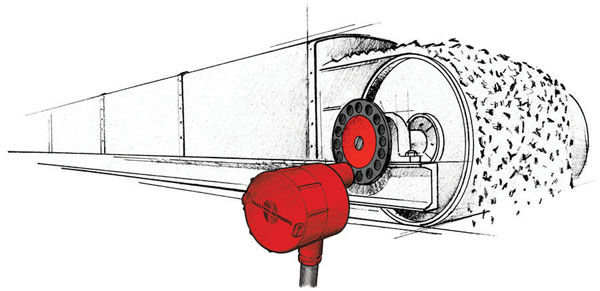Belt Conveyors have numerous applications in bulk raw materials handling ranging from mining to grain processing. They usually comprise of a continuous woven flat bed (belt) moving over a flat metal surface or metal rollers.
Conveyors can fail for a variety of reasons. Materials such as grain or rocks may be damp or wet – significantly adding to the weight on the conveyor belt and ultimately leading to belt slippage and slowdown. Conveyor belts can break due to overload, wear and tear, or the motor driving the conveyor may fail. Any one of these scenarios, if left unattended, can lead to lengthy stretches of costly downtime and wasted product. The clean up along with the time taken to carry out repairs can be much more extensive than would have been the case had a speed switch been in place. In the worst case scenario, a fault condition in a hazardous environment may lead to a situation that could endanger both people and property.
Speed switches are used to help maintain the operational integrity of these conveyors and are a critical component of any safe and efficient operation. It is vital in many cases that a relatively constant speed is maintained – if a conveyor was to experience unwanted slowdown or even complete stoppage, the results could be disastrous and dangerous. Product waste, machine damage, missed deadlines, costly process downtime, and even unsafe working conditions can all be attributed to conveyor failure.
Speed switches come in a variety of forms each designed to fit a particular application covering virtually every conveying situation. There are two piece systems, three piece systems, systems designed for explosion proof environments, corrosive environments, and dirty, dusty and greasy environments – all with the same end result in mind – to protect the operational integrity of the conveyor and larger industrial process. Speed switch systems usually monitor rotation on the tail (or non-driven) pulley via a pulse generator (usually a pulser disc or wrap with alternating polarity magnets set around the perimeter) and sensor, which in turn connects to a switch/relay module. The operator calibrates the set point (trip point) at the module using either a rotary dial or potentiometer. The set point is usually set at about 90% of operating speed (RPM) so that when a fault condition occurs, the switch will trip the relay shutting down the conveyor or activating some type of audible or visual alarm. Speed Switch Tutorial
Ratemeters and Tachometers are also used to monitor Belt Conveyors to display the RPM of the conveyor.


